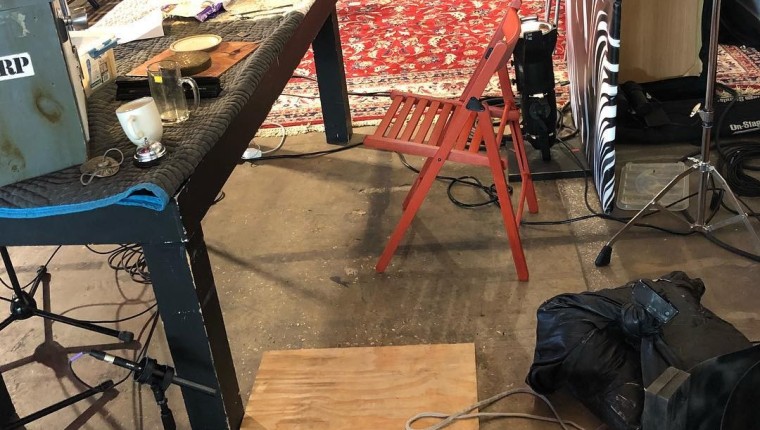By Margo Hammond
. . .
Radio Theatre Project at Studio@620
An All-Inclusive Theater of the Mind
. . .
January 23 at 7 pm
The Studio@620
Details here
. . .
NEA/Pinellas Recovers Grant Update
. . .
“Radio is a blind media,” says David Foster in his mini course on radio theater for Johns Hopkins University At Home. “We don’t see it. We hear it.”
The professor obviously never came to the Radio Theater Project at Studio@620. Now in its 17th year, these radio shows were never just about sound. As regulars know, you don’t just come to listen to the Radio Theatre Project at The Studio. You come for the sights as well. . .
. . .
- Vickie Daignault at the mic, transforming herself into a Teddy Bear, for her role in Takeover at the Toymart by Mike Murphy, a holiday show about toys who stage a revolt, performed last December.

- Matt Cowley at the Foley table, manipulating props to create the sound of a slammed door, the squeak of a floorboard or the tinkle of shattered glass.
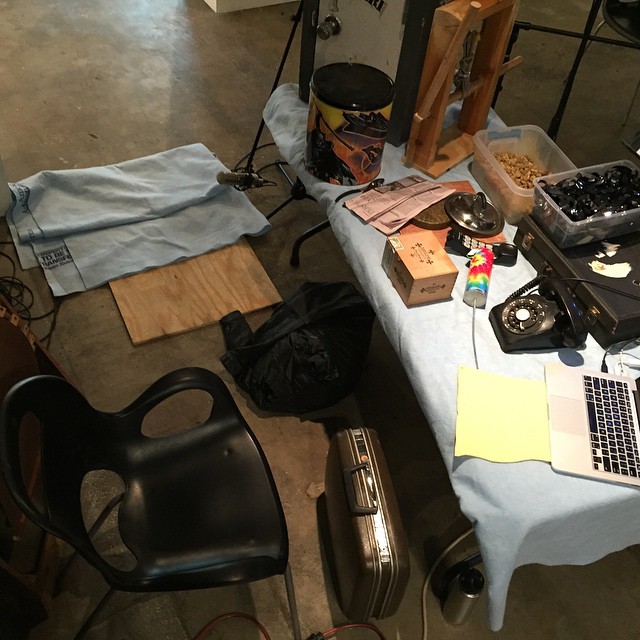
“This is what storms, burglars and invading armies look like”
– photo by Matt Cowley
- Carol Downing, an American Sign Language interpreter, using her hands, body language and facial expressions to tell stories through gestures and create characters visually.
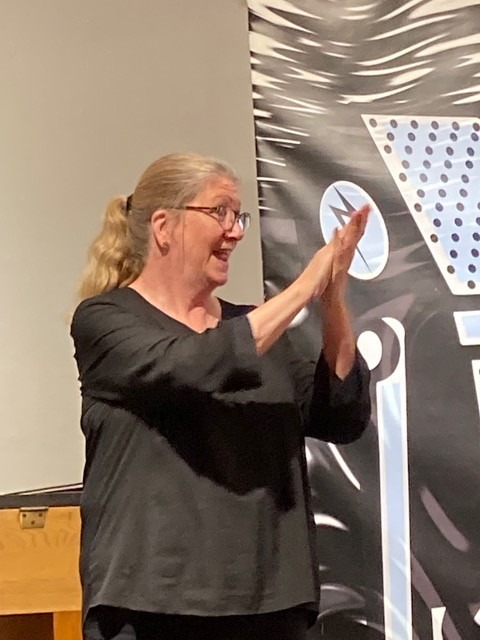
The seeds of this all-inclusive mixture of sight and sound were sown back in 2005. The Studio, newly opened, received a grant from the Community Foundation of Great St. Petersburg to commission six professional writers and six student writers from schools in South St. Pete to create live performances of radio noir dramas. To help with the sound effects, Studio@620 co-founder Bob Devin Jones made a trip to WMNF to track down Matt Cowley, the sound effects artist and host of a Wednesday night radio program called Soundstage [disclaimer – a project started in 1998 by his wife Sheila Cowley, now Managing Editor of this magazine.]

Four years later, thanks to Mimi Rice, live radio performances — complete with “special effects wizardry” by Cowley — became a permanent fixture at The Studio. As Devin Jones likes to joke, it was “Mimi’s best idea since the national parks.” Called The Radio Theatre Project (also RTP Live!), the series has become one of the most popular ongoing offerings at the creative space whose motto is “the answer is always yes.”
. . .
. . .
“I had just turned 70,” said Mimi who has been acting in St. Petersburg since she arrived in 1980, “and realized that there were not many roles here for older actors.” Reading an issue of American Theatre magazine (a publication of Theatre Communications Group) about the growing popularity of radio drama, she had an epiphany – on radio, it doesn’t matter how old you are. She went to Bob said, “Let’s do radio theater.”
And, of course, he said yes.

The first “Live Radio Performance & Broadcast Taping” debuted on November 23, 2009. “This will be just like the good old days with sound effects and all the fun!” the Studio’s promotion promised. “Come be a part of the live studio audience!”
The evening — admission was pay what you will at the door — featured two dramas. . .
. . .
- The Piano Tuner, a short story by St. Petersburg’s then-Poet Laureate Peter Meinke, adapted for radio and directed by Bob Devin Jones with Rich Rice, Ron Satlof, Bonnie Agan and Bob Devin Jones
. . . - Joseph Kesselring’s Arsenic and Old Lace, adapted for radio by Lux Radio Theatre and offered free online, directed by Rich Rice with Hersha Parady, Mimi Rice, Jim Wicker, Leroy Mitchell, Andy Orrell, Drew DeCaro and Eugenie Bondurant.
. . .
“We had no money to pay for scripts or copyright permission,” says Mimi Rice. So the project relied on plays in the public domain (such as Box and Cox by 19th century British playwright John Morton) and the generosity of local writers.
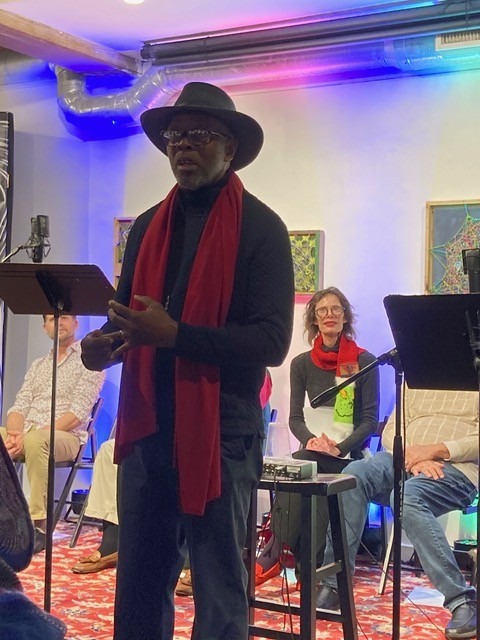
Among the plays offered in their second year of operation, a full year of shows, were an another adaption of a Meinke short story (Alice’s Brother); an radio version of a story by local baseball writer Peter Golenbock about the friendship between Pee Wee Reese and Jackie Robinson (Teammates); one act plays written and directed by local writers Paul Wilborn (My Dinner with Margo) and Andy Orell (As Four Horsemen Wait) and an original script from the WordBRIDGE Collegiate Playwright’s Lab at Eckerd College where Mimi’s husband Rich was artistic director (Some Say Fire by Eric Ramsey).
. . .
. . .
They also leaned on friends from the country’s wider theater community for fresh material. David Kranes, longtime artistic director of Sundance Playwrights Lab, for example, wrote Loss of Appetite for Rich and Mimi Rice to perform.
. . .
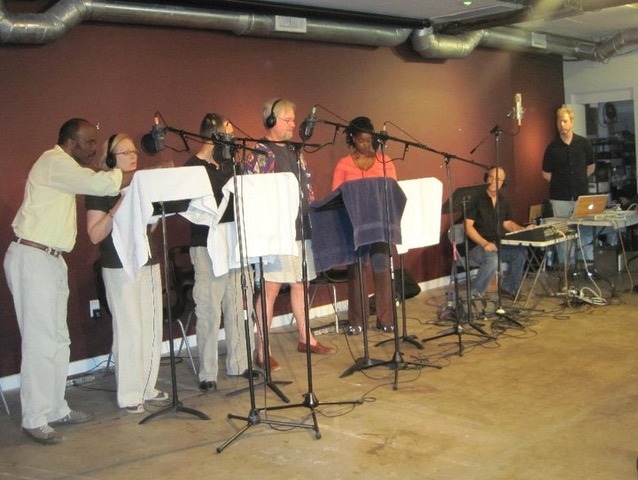
For the acting and directing, the group tapped into local talent. I once was honored to be asked to play the part of a journalist, but for the most part the actors and directors have been theater professionals — some of them well-known in film and television, including Hersha Parady (she was Alice Garvey in “The Little House on the Prairie”), Bob Heitman (he was Dr. Stan Clader in “All My Children”), Ron Satlof (he directed eight Perry Mason telefilms) and Eugenie Bondurant (she was Tigris in The Hunger Games).
Initially the ensemble worked with borrowed equipment and a less-than-sophisticated setup. “We set up music stands,” says Mimi Rice, “and during that first season, the paper made so much noise, we had to cover the stands with towels.” For Arsenic and Old Lace, they hung lace over the music stands.
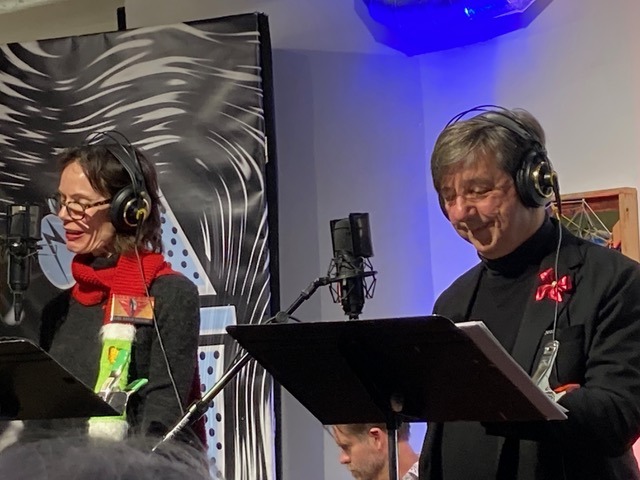
Carol Downing first started signing for the project at the end of 2010 at a Christmas performance of It’s a Wonderful Life. She was recruited by Julia Flood, one of RTP’s founding members who directed children’s theater at Eckerd College and met Downing onstage at Ruth Eckerd Hall. Downing was teaching at the Blossom Montessori School for the Deaf and often brought her students. Now a full-time professor at St. Pete College teaching sign language to hearing people, she brings her hearing students to the radio shows.

– photo by Margo Hammond
The irony of saying she signs on a radio show is not lost on Downing. She knows some people think it’s like saying, “I have a face for radio.” But she is convinced that her signing not only has made the radio shows accessible to Tampa Bay’s deaf community (the fourth largest in the nation), but also has enhanced the experience for members of the hearing audience by providing them with a glimpse into how the deaf experience the world.
“Inviting me to join the ensemble showed the forward thinking of Studio@620,” says Downing, who has a bachelor’s degree in sign language interpreting from USF and a master’s degree in administration from Gallaudet University, a private school for the deaf in Washington DC.
Along with the rest of the troupe, Downing receives a script ahead of the performance. She goes over it and circles the words for which she will need to modify a sign. American Sign Language does not translate word for word but is based on concepts, she explains. There is a sign for barking, but it has to be modified when the dog is growling or if it’s a yippy dog, for example.
“It’s a great challenge,” says Downing. “If a person in the script is slurring their words, I have to adjust my signs to show that.”
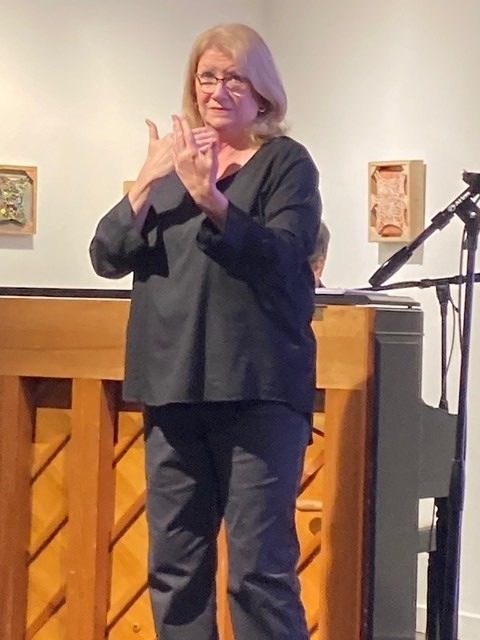
She continually tests out her modifications on deaf friends to see if they work. Is it a man who is drowsy? they’ll ask. No, not quite. Drunk? Bingo, she got it right. Her most challenging moment? The time a script called for her to sign about an octopus who fell in love with its researcher. “I had to be that octopus looking up at her fondly and gazing into her eyes.”
Watching someone tell a story without words is mesmerizing. “Some people tell me they close their eyes and listen during the live performances — radio, after all, is called the ‘theater of the mind,’” says Bonnie Again who began as an occasional actor with the project but is now its director, “but others tell me that they find themselves watching Carol signing throughout the evening.” Her work is a performance in itself.
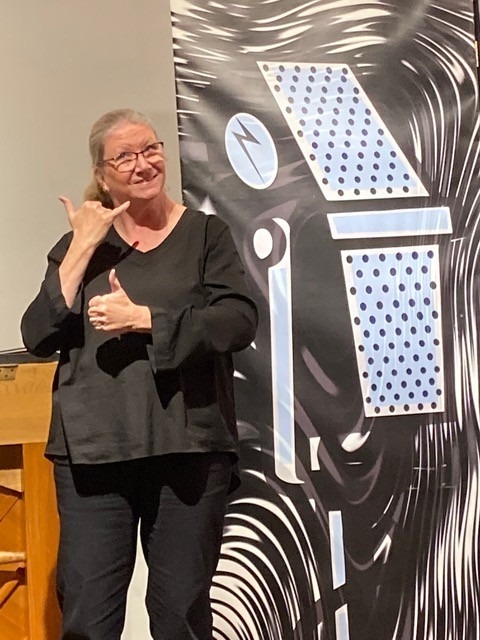
Audience members also love to watch Foley artist Matt Cowley, Agan adds. “Matt had to train himself to make sounds in a much more visual way than he’d do on a pre-recorded show, because people come to watch him do the Foley,” says his wife Sheila Cowley. “Our house and garage are bursting with wooden squeak contraptions, and tins of nuts and bolts that make you sound like you’re having an accident every time you turn a corner when they’re in the car.”
Jim Howell (Devin Jones’ husband who is a professional contractor) made a prop door for Matt to use in those first performances, she remembers, but it worked too well – it wasn’t noisy enough! The team was forced to wrench Howell’s perfect hinges and rub sand in the joints, to try and get his well-made door to squeak.
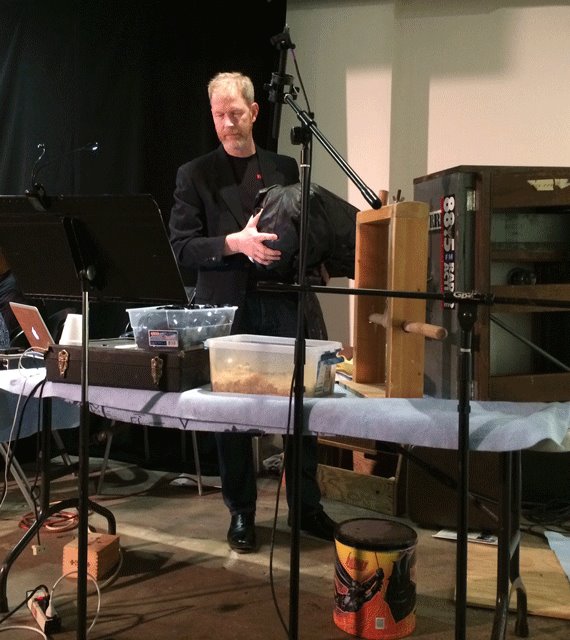
Watching the actors themselves, of course, is part of the visual experience of The Radio Theatre Project – but you can’t view them in the same way as you would if they were on a traditional stage. Radio actors are unable to use the usual cues of a stage production, Bonnie Agan points out. Grabbing a purse, for example, which in a stage play would be an action, has to be vocally indicated when you are doing it in a radio drama.

“It’s very different from acting onstage,” agrees Mimi Rice. “You have to create a character verbally. It involves a wonderful process of listening.” The experience, she says, has made her a better actor. “When I do a stage play, I now have a much better sense of listening to the other actor and responding fresh.”
Unlike a stage production which holds multiple rehearsals because you want it to be the same every night, these radio plays only have one. “For radio you want a fresh response,” says Mimi Rice. “I’ve created my character and hear the other and we react to each other. At a table rehearsal the actors read through the script together followed by a tech rehearsal to coordinate the sound effects, position where we sit and set the mic stands for heights. Some of us are very tall and some of us are very short!”
Some of pieces the ensemble performs were written specifically for radio, but many times the work has to be adapted. “We call it ‘radioizing,’” says Agan. “It’s a lot of work.”
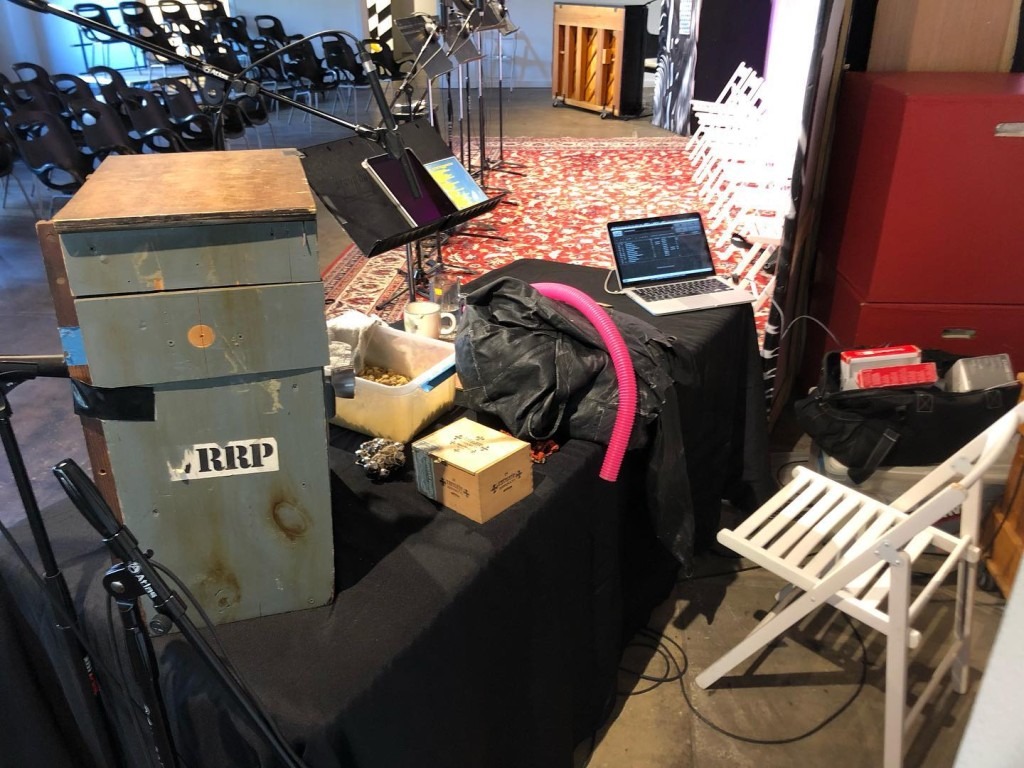
Initially, the radio plays recorded at Studio@620 were replayed on WMNF during Cowley’s Soundstage show. When the community radio channel changed its format, Soundstage was moved to its digital channel and the plays aired there. Now RTP’s work since Season 1 is available online via Soundcloud.
Last year the Radio Theatre Project’s Soundcloud site recorded 869 hits from listeners all over the globe, from Staten Island to Uzbekistan. Marina Del Ray by Jack McCleland registered 77 hits. Also popular — 72 hits — was that first performance of Arsenic and Old Lace.
Every year the radio project enters the Atlanta Audio Theater Fringe Festival. You can listen to The Nick Files: Cupid is as Cupid Does by The Radio Theatre Project which was their entry last year for the 10th annual fringe festival. In 2020 the troupe won the Critic’s Award for Rosa & Leo and also were rated best for Writing and Creativity. They have won the Audience Favorite award, an award for Old Time Radio Theater Show and for Future Oriented Play.
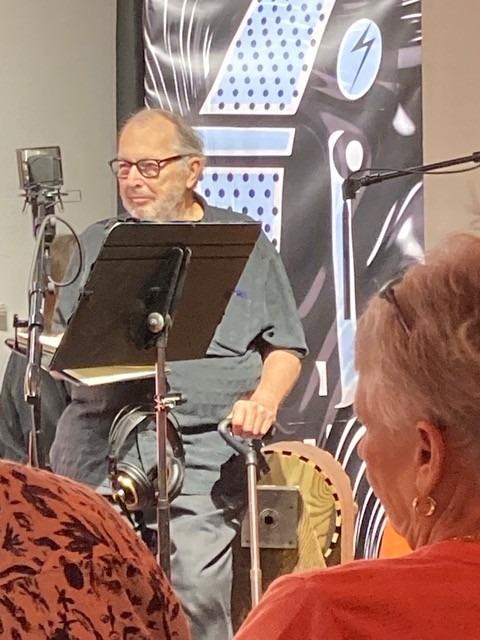
Mimi Rice hopes that one day the Radio Theatre Project could get back on radio.
Meanwhile, audiences for the live performances have continued to grow. “We do have faithful regulars,” says Bonnie Agan. But after the hiatus of the pandemic when the shows were suspended, Agan noticed a lot of new faces.
“Last year I kept it very light,” she says. “There was enough darkness going on and I think people come for a break from that darkness. I felt a responsibility to provide that. I always try to end on a light note, to leave them laughing.”

Dramas based in Florida or written by Floridians have always drawn some of the largest crowds, including Doug Cooney’s hilarious Live Alligator Wrestling, Phyllis McEwen and Bob Devin Jones bringing Zora Neale Hurston’s research to vibrant life in Florida Folk and the Tales They Do, and food writer and editor Janet Keeler’s Elephant in the Room, a tete-a-tete between a woman and her bathroom scale.
. . .
. . .
Perhaps the most popular though was an ongoing series — The Adventures of Noel Berlin, Cabaret Dectective — which ran from 2012 until 2016. Written especially for the Radio Theatre Project by Paul Wilborn and Matt Cowley, the series set in a mythical St. Pete combined cliffhanger episodes with cabaret music and stunning sound effects.
This year — the year of the Rabbit — the Radio Theatre Project appropriately is offering a wacky episode from The Nick Files by Dan Fiorella called “The Big Rabbit,” which borrows characters from the classic play Harvey. 2023’s first performance, on January 23 at 7 p.m, will also feature James Rayfield’s Isn’t It Lovely, dark humor that looks at the possible conclusions of cryogenics, and A Siri-Ous Situation by J. Lois Diamond which explores a man’s bizarre relationship with Siri.

There have been some changes in the live performances over the years. A ticket now costs $15 ($10 for Studio members). The group has a professional frame. Actors and playwrights get some compensation. “We have gotten more professional. Now we have a personality,” says Mimi Rice.
The early charm of the event with its echoes of old time radio still is intact though. Paul Wilborn kicks off the evening with tunes on the piano. Carol Downing still signs. Matt Cowley still mans the Foley table. The group still relies for the most part on local talent at the mics and for the scripts. To continue, however, warns Agan, there is an urgent need for sponsors — not only for any reprise of a radio presence but for the live performances as well.

Sponsors, of course, certainly would be in keeping with that old time radio spirit. Can’t you just see (and hear) it? “And now a word from our sponsor…”
And we can only wonder what signs Carol Downing would come up with for “Plop Plop Fizz Fizz What a Relief It Is.”
. . .
.soundcloud.com/radiotheatreproject
. . .
The Studio@620 was a recipient of the
Pinellas Recovers Grant provided by Creative Pinellas
through the National Endowment of the Arts American Rescue Plan.
This article is the third in a series
about the activities of this creative space.

– photo by Matt Cowley
